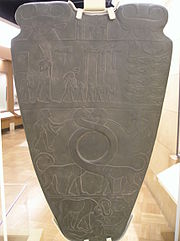
Serpopard
Encyclopedia

Ancient Egypt
Ancient Egypt was an ancient civilization of Northeastern Africa, concentrated along the lower reaches of the Nile River in what is now the modern country of Egypt. Egyptian civilization coalesced around 3150 BC with the political unification of Upper and Lower Egypt under the first pharaoh...
ian depictions. This term is not used in any original texts, and is an interpretation made only recently. The image is featured specifically on decorated cosmetic palettes
Cosmetic palette
The cosmetic palettes of middle to late predynastic Egypt are archaeological artifacts, originally used to grind and apply ingredients for facial or body cosmetics. The decorative palettes of the late 4th millennium BCE appear to have lost this function and became commemorative, ornamental, and...
from the Pre-Dynastic Period
Predynastic Egypt
The Prehistory of Egypt spans the period of earliest human settlement to the beginning of the Early Dynastic Period of Egypt in ca. 3100 BC, starting with King Menes/Narmer....
. Examples include the Narmer Palette
Narmer Palette
The Narmer Palette, also known as the Great ierakonpolis Palette or the Palette of Narmer, is a significant Egyptian archeological find, dating from about the 31st century BC, containing some of the earliest hieroglyphic inscriptions ever found. It is thought by some to depict the unification of...
and the Small Palette of Nekhen
Nekhen
Nekhen was the religious and political capital of Upper Egypt at the end of the Predynastic period...
(Hierakonopolis). The image exists in other contemporary cultures as well and the cylinder seal displayed to the right displays the motif very clearly.
The "serpopard" has been defined as a cross between a serpent
Serpent (symbolism)
Serpent in Latin means: Rory Collins :&, in turn, from the Biblical Hebrew word of: "saraf" with root letters of: which refers to something burning-as, the pain of poisonous snake's bite was likened to internal burning.This word is commonly used in a specifically mythic or religious context,...
and leopard
Leopard
The leopard , Panthera pardus, is a member of the Felidae family and the smallest of the four "big cats" in the genus Panthera, the other three being the tiger, lion, and jaguar. The leopard was once distributed across eastern and southern Asia and Africa, from Siberia to South Africa, but its...
and is supposed to feature the body of the latter and a long neck and head representing the former.
The image generally is classified as a feline
Felidae
Felidae is the biological family of the cats; a member of this family is called a felid. Felids are the strictest carnivores of the thirteen terrestrial families in the order Carnivora, although the three families of marine mammals comprising the superfamily pinnipedia are as carnivorous as the...
, however, and with close inspection resembles an unusually long-necked lion
Lion
The lion is one of the four big cats in the genus Panthera, and a member of the family Felidae. With some males exceeding 250 kg in weight, it is the second-largest living cat after the tiger...
esses instead. It bears the characteristic tuft of the species at the end of the tail, there are no spots, the round-eared head most closely resembles the lioness rather than a serpent because serpents do not have ears, and there are no typical serpent features such as scales, tongue, or head shape.
Similarly to other ancient peoples, the Egyptians are known for their very accurate depictions of the creatures they observed. Their composite creatures, assembled for deities who had become merged in religious concepts, have very recognizable features of the animals originally representing those deities merged.
Lionesses played an important role in the religious concepts of both Upper and Lower Egypt and are likely to have been designated as animals associated with protection and royalty. The long necks may be a simple exaggeration, used as a framing feature in an artistic motif, either forming the cosmetic mixing area in the Narmer Palette or surrounding it in the Small Palette.
Depictions of fantastic animals also are known from Elam
Elam
Elam was an ancient civilization located in what is now southwest Iran. Elam was centered in the far west and the southwest of modern-day Iran, stretching from the lowlands of Khuzestan and Ilam Province, as well as a small part of southern Iraq...
and Mesopotamia
Mesopotamia
Mesopotamia is a toponym for the area of the Tigris–Euphrates river system, largely corresponding to modern-day Iraq, northeastern Syria, southeastern Turkey and southwestern Iran.Widely considered to be the cradle of civilization, Bronze Age Mesopotamia included Sumer and the...
, as well as many other cultures.
External links
- good images of Narmer Palette by Francesco Rafaele

